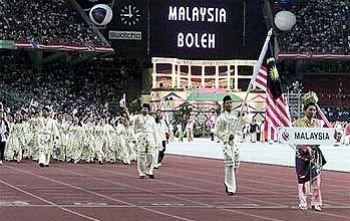
Riding on the spirited slogan of "Malaysia Boleh" (Malaysia Can), Malaysia passed with "flying colors" when it successfully staged the last Commonwealth Games of this century -- the 16th Commonwealth Games -- or the Kuala Lumpur 98 from Sept 11 to Sept 2, 1998.
The 16th Commonwealth Games held for the first time in Asia, was a first for Malaysia and the biggest sporting event that it has ever hosted. It was attended by 5,000 athletes and officials from 70 countries with a record number of 16 sports including the debut of team events.
Head of the Commonwealth, Queen Elizabeth officially closed the Games, also hailed as the biggest and best ever in the Games' history at the Olympic-class National Stadium in Bukit Jalil on Sept 21.
"Malaysia promised us the best Games ever and they have delivered that promise," Commonwealth Games Federation chairman Michael Fennell said during the Games' closing ceremony at the 100,000-seat National Stadium in Bukit Jalil which was packed to capacity.
Organizing chairman Gen (R) Tan Sri Hashim Mohd Ali said in his closing speech that "we lived up to our expectations and our promises. The best Games ever and we all saw it here in Kuala Lumpur."

To the fanfare of trumpets and dancing laser beams, Datuk Seri Dr Mahathir Mohamad declared open the National Sports Complex in Bukit Jalil on July 11, 1998 to catapult Malaysia into the ranks of a world-class sports infrastructure nation and a future Olympics host.
Located 20km south of the capital, the RM800 million world class complex served as the hub of the 16th Commonwealth Games in 1998.
The dazzling opening ceremony, televised "live" by RTM, was staged in the jewel of the complex, the 100,000-capacity main stadium that was officially named Stadium Nasional or the National Stadium by the Prime Minister.
Built by United Engineers M Bhd and completed three months ahead of schedule of the Games beginning Sept 11, the 120-hectare complex, marks the coming of age of Malaysian sports. It had taken 25 years to realize the dream of a national sports complex mooted by second Prime Minister Tun Abdul Razak in 1973.
The other facilities at the complex -- the Putra Indoor Stadium, the National Aquatic Centre, the National Hockey Stadium and the National Squash Centre -- were also used during the 16th Commonwealth Games.
Described as the "sports complex in a park", it is the only one of its kind in the country or region when it is fully developed.
All the stadiums have sophisticated facilities built in accordance with international standards while the indoor stadium can also be used for non-sports events.

Part of the massive National Sports Complex, the outdoor stadium which cost RM554mil has a seating capacity of 100,000 and has 200 seats for the disabled.
Work on the stadium began in 1994 and was completed just before the Commonwealth Games in 1998. The stadium was venue of the Games' opening and closing ceremonies as well as the athletic events.
The 100,000 capacity stadium covering 76,000 sq meters of land, has three spectator tiers and all functional and secondary areas are on two levels below the main concourse. Its bowl shape is emphasized by the three overlapping spectator tiers which give the stadium a dramatic look.
The 68m X 105m field has a nine-lane 400m tartan track with pits for the steeplechase. The track complies with international (IAAF) specifications. In addition to the track, the stadium also has a 9 x 400m synthetic track lane and a 6m x 600m track specially for warming-up linked to the main stadium via a tunnel.
When the stadium is not in use, the seats which are in various colors create the visual effect of the Malaysian flag in motion.
High-tech features include a dynamic sound system to broadcast music and messages as well as a pre-programmed flood-lighting system.

The "jewel" of the National Sports Complex, the world class National Stadium, was designed to host a multitude of events. The modern track and field facilities at the stadium are ideal for athletic meets and international football venue.
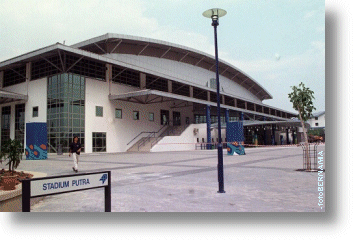
The indoor stadium - the gymnastics venue for the Commonwealth Games - has been designed as a sports and venue for functions such as concerts, expositions, gatherings and conferences.
The multi-purpose stadium which has 16,000 seats, can accommodate more spectators than the actual number of seats as 13,000 of the seats can be dismantled.
Visitors have open unobstructed access into the stadium from the surrounding pedestrian plazas and entrances are situated on three sides of the building. The Putra Indoor Stadium is equipped with a four-sided, full color video matrix scoreboard.
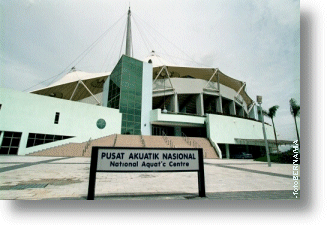
The fully-covered center has permanent seating for 4,000 spectators and temporary seats for 2,000 more. The Olympic-size swimming pool at the National Aquatic Centre complied with international specifications and can hold world class events.
It has competition pools for swimming, diving and synchronized swimming, all built within the regulations of the world swimming body, the International Swimming Federation (FINA).
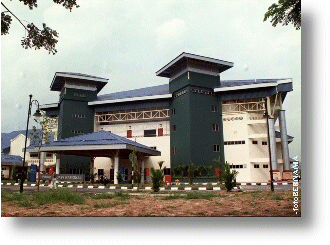
This stadium has been rated among the world's biggest and best equipped for squash events. By the flick of a switch, all the 10 courts for singles can be converted into eight doubles courts. The walls can be rearranged to form a bigger court which makes this complex a multi-purpose one.
The 11th centre court, a full glass-sided court, has a permanent seating
capacity of 1,000 while the double-level centre is fully air-conditioned.
The total built-up area of the National Squash Centre is about 7,030 sq meters.
It has a player's lounge, changing rooms, medical and conference room, press
centre, cafeteria and more than 20 lounges.
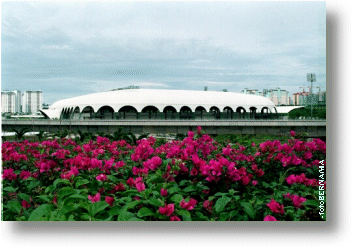
The National Hockey Stadium is made up of two stadiums, namely the National Hockey Stadium 1 (main stadium) and the National Hockey Stadium 2 which are located next to each other.
The main stadium can accommodate 12,000 spectators, all in full covered seats. Among the facilities available at the main stadium are conference room, doping control centre, media centre, a spectator first aid room, a physio room, a medical centre and dressing rooms.
The National Hockey, Stadium 2 has seating capacity for 2,000 spectators with covered seating for 1,000. This secondary training and warm-up stadium provides facilities for VIPs, police, general and technical administration and the press. Changing rooms, cafeterias and other amenities are also available.
Other sports centres available in Kuala Lumpur include:
Kuala Lumpur Badminton Stadium in Cheras
Kuala Lumpur Velodrome
Pyramid Bowls, Sunway Pyramid
Kelab Aman Ampang
Royal Military College
Hockey Stadium Lembah Pantai
Victoria Institution
Selangor Turf Club
|
|
XVI COMMONWEALTH GAMES 1998 Kuala Lumpur played host to the four-yearly Commonwealth Games in 1998 from the 10th to the 20th of September. This was the 16th Games in the series first held in Hamilton, Canada in 1930 (known then as the British Empire Games). The Commonwealth Games is basically like the Olympic Games except that the participants are former British Empire colonies. There was a turnout of 70 nations, competing in 16 events. |
Glitter and gold
The rush is on, for the 386 gold medals at stake, for the 773 athletes, for the 15,000 volunteers and security forces personnel manning the venues, the 7,000 school children involved in the opening ceremonies, and to create history by organizing the first SEA Games in three cities.
As the fireworks lit the sky at the National Stadium in Kuala Lumpur, more than 50,000 people cheered and rejoiced in celebration of the dayís golden achievements and to usher in the two-week friendly Games among the 10 competing nations.
The enthusiastic crowd and over 5,000 athletes broke into a deafening roar the moment the Yang di Pertuan Agong declared: ďLet the Games begin.Ē
Parallel ceremonies at the Larkin Stadium in Johor Baru and the Penang International Sports Arena made the first SEA Games of the new millennium a most memorable event.
There was an almost endless round of cheers and applause at the National Stadium throughout the four-hour Games opening extravaganza.
Excitement took all forms, such as paratroopers sailing in from the clear sky, carrying the national flags of the 10 countries of the SEA Games fraternity.
Prime Minister Datuk Seri Dr Mahathir Mohamad and his wife Datin Seri Dr Siti Hasmah Mohd Ali, riding in an open top army 4WD and waving to the crowd were given a rousing and enthusiastic reception by the spectators.
The Rakan Muda choir, which rendered the patriotic ďKeranamu MalaysiaĒ, kicked off a chain of performances including formations, songs and dances.
The highlight of the event was the marching-in of the national contingents comprising some 5,000 sportsmen and sportswomen from all over South-East Asia. They were led by Games mascot Si Tumas.
As each contingent entered the stadium, the giant electronic scoreboard flashed greetings in their national language, such as Minga la par (for the Mynmar team) and Mabuhay (for the team from the Philippines).
The loudest cheers were for the home team, with flag bearer Nurherman Majid leading the nationís 558 athletes amid the ecstatic welcome by fans waving the Jalur Gemilang.
The Games torch was brought into the stadium by former national soccer star Datuk Soh Chin Aun and former Philippines track queen Maria Lydia DíVega Mercado, who then passed it to 19 other runners before the final lap was taken by former cycling ace Daud Ibrahim.
From the stage, he held the flaming torch to light a wire leading to the main cauldron at the opposite end of the stadium.
As it lit up, thousands of balloons and confetti poured over the spectators amid more cheers and applause. This signaled a jubilant start to the biggest biennial sports meet in the culturally-rich South-East Asian region.
The Games had unofficially kicked off with the menís and womenís football competitions last Saturday and yesterday Malaysian athletes from the menís gymnastic squad and equestrian team did the nation proud by delivering its first two golds.
The menís gymnastic team had amassed 208.35 points to shock favourites Thailand by a whisker to win a surprise gold for Malaysia while the Equestrian Endurance duo of Datuk Kamaruddin Abdul Ghani and Dr Nik Ishahak Wan Abdullah galloped for almost seven hours to deliver the top two positions for Malaysia at the Sungai Labu Estate in Sepang.
More than 15,000 support staff, mostly comprising of police and armed forces personnel, will be involved in the running of the 10-day Games.
